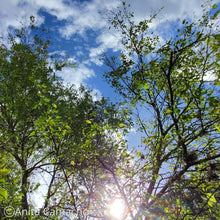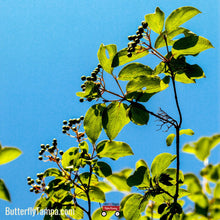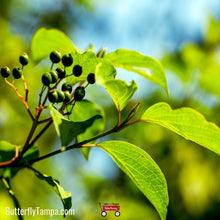Sugarberry or Southern Hackberry (Celtis laevigata) is a deciduous tree with a round crown. The tree easily grows to 50-70 feet tall with a canopy as broad as the tree’s height and a trunk diameter of 3 feet. Its branching structure and bark have been described as remarkably similar to that of the American Beech. Sugarberry is commonly found along streams, woodlands, and low-lying bottomlands across its native habitat which includes much of the southern United States: it ranges from Virginia to Florida, westward through Tennessee, Arkansas, Oklahoma, and Texas. The tree tolerates clay soils and thrives in fertile, sandy loam soils.
The tree’s common name describes the tree’s very sweet, very juicy berries which are a favorite of at least ten species of birds including robins, mockingbirds, and cedar waxwings. Some small mammals also enjoy the tasty fruit. Birds frequently nest in the tree and its leaves are food for the caterpillars of the Hackberry Emperors, Tawny Emperors, American Snout and Question Mark butterflies.
A number of Native American tribes used Sugarberry: the Houma made a concentrate from the tree’s bark to treat sore throats. The Comanche mixed pulp from the berry with animal fat for food while the Acoma, Navajo and Tewa ate its berries. The Navajo made dye from Sugarberry’s leaves and branches.
Sugarberry is drought resistant and resistant to most debilitating pests. (It is, however, parasitized by mistletoe.) The University of Florida recommends that homeowners have an arborist prune this tree several times during its first 15 years to prevent the development of multiple trunks or weak branch crotches. If you have ever been lucky enough to visit Savannah, GA, you may well have seen it; Savannah plants it widely as a street tree.
Have you seen them here in Tampa Bay? If so, why not post a photo with its location to our Facebook page? We’d love to see more of them in our area. If we know where the trees are, there is a good chance we will see the butterflies during their season in Florida.
- Tree
- Size: 60-80 ft. tall by30-50 ft. wide
- Flower: Yellow blooms early spring
- Fruit: Brown, ripens in fall
- Exposure: Full sun, part shade
- Moisture: Well-drained
- Soil: Sand, clay, loam
- Larval host plant for Hackberry Emperor, Mourning Cloak, American Snout, Tawny Emperor, and Question Mark butterflies
/djs






